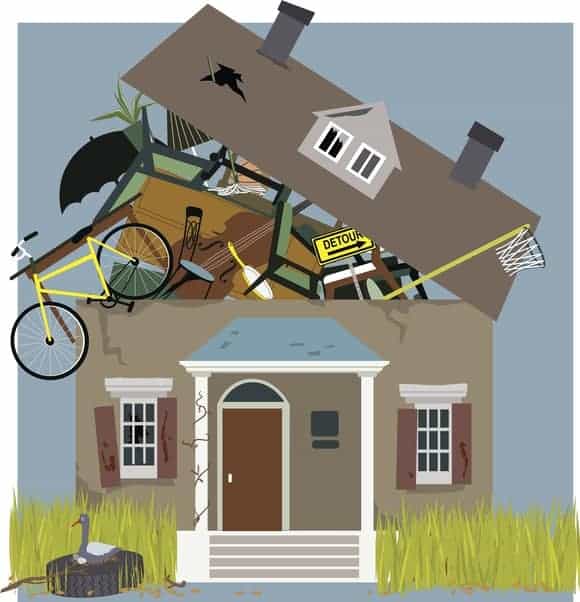
Over the next few months, we will be interviewing professionals who work with the hoarding population. We are asking them to share their insight on people who hoard and people who think they have the hoarding disorder.
We recently interviewed Alison Lush. Alison is a member of Professional Organizers in Canada (POC) and The National Association of Productivity and Organizing Professionals (NAPO). She is also a Certified Professional Organizer, a Certified Professional Organizer in Chronic Disorganization, and an ICD Master Trainer. Because she lives in Quebec, she conducts her business in both French and English.
Everything related to organizing that Alison studied, she wondered about in terms of her own life. She developed the understanding that she has a “relationship” with her things. There is a flow – things come in and things go out. Her home supports her goals.
Alison never wants to stop learning. She recognizes the importance of education and plans to be engaged in professional studies forever.
Questions & Responses
What training have you taken?
I began with training from the POC (Professional Organizers in Canada). I have earned my NAPO (National Association of Productivity and Organizing Professionals) CPO® and my CPO-CD® (Certified Professional Organizer in Chronic Disorganization) through ICD (The Institute for Challenging Disorganization). Recently I earned my Master Trainer certification.
What percentage of your clients do you suspect have hoarding tendencies?
I believe that it is less than 5%. We must remember that only medical professionals – psychiatrists – can make that designation.
As you start working, are there times when you discover this is something other than hoarding?
The term hoarding is used too loosely and too quickly. The term should never be used unless a proper diagnosis has been made. For example, I had someone come to me and say, “I have hoarding disorders.” She had seen professionals and social workers and was very involved in the process. When I met her she was preparing to move. She had been in her current home for 17 years. As we started to work, the diagnosis seemed not right. She had no trouble getting rid of items, even items I had left behind for her to take out. When I asked her again about who diagnosed her, she stated, “Oh, I diagnosed myself.” When she was in the program, the staff accepted her diagnosis as gospel. After more work and conversation, I suggested that she might be affected by chronic disorganization rather than hoarding.
What tool do you use to determine the amount of clutter?
I use the ICD Clutter-Hoarding Scale®. I also do an interview with the client. I used to rely on my eyes but now I go with the feeling. I try to go into the home like I am wearing blinders – like I am blind, and I only listen to the client. I ask myself: What is the client feeling about the clutter? If I didn’t, I might want to start clearing an area that didn’t bother the client. I want to be sure I am addressing the needs of the client. Thanks to the Clutter-/Hoarding Scale®, I also pay attention to odors and safety issues.
How do you determine if the working area is safe for you and your client?
I pay attention to the rats’ nest of cords. I want to be aware if circuits are being overloaded. I also listen to the client. If they say something like, “Oh, we had a flood upstairs last year.” I start to look at the structure and to look for mold. I am conscious of the air quality. I also am always aware of what exits are available.
Do you usually work alone or with a team?
I tried a couple of times to work with a team, but I have found that trust and instinct are critical and very personal, so I prefer to work alone.
Would you be willing to share something you learned (maybe the hard way) from a client?
I had a client who called but seemed very ambivalent on the phone. But she also seemed very desperate. I met with her. She lived in the upper level of a duplex with the owner living on the main level. She had to move in two months. I proposed bringing in two organizers to help sort. She agreed to that arrangement. She put down a deposit. When we arrived about 10 minutes before our appointment and were sitting in the car, she called us and told us not to come in. She didn’t feel ready. We gave her some time and waited in the car. She never let us in even though she prepaid. Lesson: listen to your gut.
Another client owned 14 properties. The entire first floor of the area we were to work in was filled with flat baskets and these baskets were filled with paper. This was her filing system. She was wanting to micromanage the job. I referred two junior organizers and a tech person to her. She wanted help getting a filing cabinet set up. When I tried to talk to her, several times she put up her hand and said, “Stop talking!”. I finally got on the phone with her for about a half hour and basically fired myself. I felt we were not the right fit. I closed the account and sent her the $57 left in the account. She was not happy with me or the way I closed out the job. I wish I had never started, and I wish I had kept a good paper trail. Lesson: when there have been verbal conversations, follow up with an email spelling it all out and keep copies of the email correspondence.
Then there was Christopher. I worked with Christopher for two and a half years. He had a white-knuckle grip on everything. If he had a corner piece of Styrofoam from years back, he wanted to hang onto it because it might come in handy. I had helped him unload a part some years ago. How do I know if this is Chronic Disorganization or hoarding? If the client is willing to let you walk out with some of the items you have sorted, it is probably not hoarding. If there is a very powerful emotional psychic glue between the client and him letting go of items, it might very well be hoarding. Lesson: know what you are working with.
What advice would you give someone considering going into this field?
Get a good education. Volunteer in the professional community. Really become a part of that community. The professional community provides great resources. You can ask questions in the online forums to get advice when you are stuck.
Do you have a shareable list of resources for people challenged by hoarding or their families?
I would love to share my YouTube channel – https://www.youtube.com/channel/UCSO8GIf5LswoDiU3OgBjdqw/videos . Just last week, my most popular video passed 250K views, and very soon I will have 5000 subscribers.
Thank you very much for this fabulous time spent together learning more about the work you do.
If you are or if you know a professional who works with people with hoarding tendencies, please feel free to get in touch with us. We’d love the opportunity to talk with you, too!
Diane N. Quintana is a Certified Professional Organizer, Certified Professional Organizer in Chronic Disorganization, ICD Master Trainer and owner of DNQ Solutions, LLC based in Atlanta, Georgia. Diane teaches busy people how to become organized and provides them with strategies and solutions for maintaining order in their lives. She specializes in residential and home-office organizing and in working with people challenged by ADD, Hoarding, and Chronic Disorganization.
Jonda S. Beattie is a Professional Organizer and owner of Time Space Organization based in the Metro-Atlanta area. As presenter, author of three books as well as a retired special education teacher, she uses her listening skills, problem solving skills, knowledge of different learning techniques, ADHD specialty, and paper management skills to help clients tackle the toughest organizational issues. Jonda does hands on organizing, virtual organizing, and moderates a Zone Plan Teleclass for those who prefer to work on their own with organizational coaching.


I am a health care professional working with individuals with hoarding disorder in the UK I have co authored a self help book title Overcoming Hoarding part of the Robinson series.
I world be happy to speak to you about this condition.
I am a health care professional working with individuals with hoarding disorder in the UK I have co authored a self help book title Overcoming Hoarding part of the Robinson series.
I world be happy to speak to you about this condition.